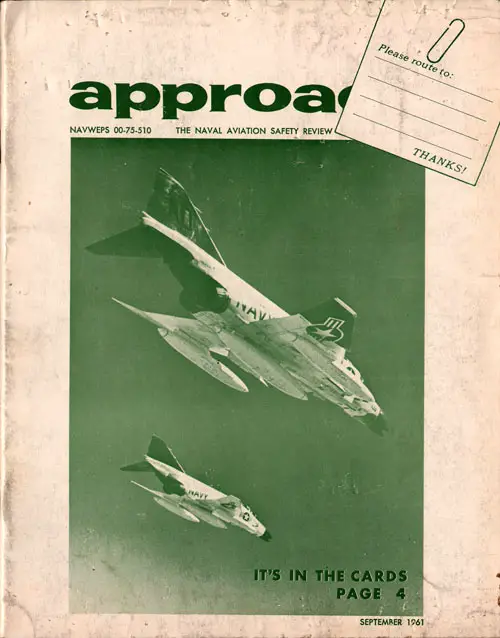Approach - Point of No Returns - September 1961

Two of the Navy's newest fighters, McDonnell F4Hs, streak through the blue. These Phantom 11s of VF-101 Det. Alfa are being maintained by a new maintenance system described in this issue.
Our Product is safety, our process is education, and our profit
is measured in the preservation of lives and equipment.
APPROACH, the Naval Aviation
Safety Review
Published by the
Naval Aviation Safety Center
SEPTEMBER 1961, VOLUME 7 NUMBER 3
CONTENTS
- IT'S IN THE CARDS
by LCDR C. H. Barfield 4
The new look in aircraft maintenance management and its relation to safety - POINT OF NO RETURNS 13
Unit improvement often hinges on the prevention of haphazard maintenance - LOST 20
Not asking for outside assistance when disoriented can sometimes be fatal - PARACHUTES IN HELICOPTERS?
by 1st It Joachim A. Crognale, U.S. Army 23
Information concerning helicopter bailout procedures is a definite necessity - YOURS FOR THE READING 28
Can a mayday result from an unwarranted lack of knowledge of your aircraft? - WE ARE LEAVING THE AIRCRAFT 31
An in-flight fire and the subsequent bailout offer a vivid, descriptive lesson - WHERE AM I? 33
Knowledge of emergency locator devices is a must for pilots and controllers - PERSEVERANCE PAYS OFF 38
It's unusual when an aircraft "ground checks negative" and "flight checks OK" - TORQUING B-NUTS 40
There is only one correct way to tighten a B-nut to prevent leakage and turning - ACCESS PANEL SCREWS 42
More careful handling of access panel screws can reduce airplane down time - WELL DONE INSIDE BACK
The aid of an air controlman is welcome assistance during a case of vertigo
DEPARTMENTS
- Letters 2
- Monitor 14
- Truth and Consequences 16
- Anymouse 28
- Development of USN Aircraft 24
- Headmouse 26
- Flight Surgeon's Notes 36
- Maintenance Notes & Comments 44
- Murphy's Law 47
- Clipboard 48
COVER PHOTO AND ART CREDITS IPp 4, 5; Robert McCall, Courtesy G. E. "Jet Service News" Cover, pp 7, 8, 10, 11, 12; VF-101 Det. Alfa P 33; LCDR E. T. Wilbur Back Cover; Courtesy USAF
Analysis and Research Maintenance and Material Aero-Medical
Crash Investigation
Records
HAIL AND FAREWELL
With This issue, APPROACH regretfully says "so long" to a key member of its staff—Commander David M. Hume, who has served the Navy and the Center well for two years as Managing Editor of APPROACH.
He distinguished himself in performing the myriad of inspiring and perspiring duties which fall to M.E.—author, critic, coordinator, father confessor, to name but a few.
Commander Hume, who is now attending Naval War College at Newport, R.I., was succeeded by Commander Thomas A. Williamson, whose wealth of aviation and journalistic experience will help influence the future course of what we hope is your favorite aviation safety magazine.
LIFTand DRAG
Paper Programs
A BRIEF report of BuWeps aviation safety officers' observations made during Inspector General surveys of 34 Naval and Marine Air Stations and associated outlying aviation facilities was presented. Major observations were:
- a. Many commands have excellent safety programs on paper, but many fail to follow up instructions and orders to insure compliance on a daily routine basis. Very seldom were officers or chief petty officers observed on the ramps or flight lines actively engaged in supervision of the men during ground servicing of aircraft or maintenance.
- b. Adequate command attention is being given to the in-flight and pilot education aspects of aviation safety.
- c. Inadequate inspection and supervision of the airfield, shoulders, overruns, runway arresting gear, control tower, ramp areas, and maintenance shops was a common discrepancy noted.
- d. Stations inspected which had a successful and effective aviation safety program had a relatively senior officer assigned the billet of aviation safety with primary responsibility to conduct the station's safety program. Those stations with weakest programs and most glaring discrepancies had in every case assigned the aviation safety program to a junior officer in the operations department as a collateral duty.
- e. There appears to be a need to transpose the emphasis and command attention given accident prevention by the higher level Aviation Safety Council system into down-the-line station supervision in areas where the work is done and accidents are bred.—Report on Aviation Saf ety Environment on Air Stations —(BuWeps)
Publication Information
Purposes and Policies: APPROACH is published monthly by the U.S. Naval Aviation Safety Center and is distributed free to naval aeronautical organizations on the basis of 1 copy per 12 persons. It presents the most accurate information currently available on the subject of aviation accident prevention.
Contents should not be construed as regulations, orders, or directives. Material extracted from Aircraft Accident Reports (OpNays 3750-1 and 3750-10), Medical Officer's Reports (OpNav 3750-8) and Anymouse (anonymous) Reports may not be construed as incriminating under Art. 31, UCMJ.
Photos: Official Navy or as credited. Non-naval activities are requested to contact NASC prior to reprinting APPROACH material.
Correspondence: Contributions are welcome as are comments and criticisms. Views expressed in guest-written articles are not necessarily those of NASC. Requests for distribution changes should be directed to NASC, NAS Norfolk 11, Va., Att: Literature Dep't., if you are receiving the magazine free because of military or commercial contact status with the Navy. . . .
IF YOU ARE A PAID SUBSCRIBER, address all renewals and change of addresses to Superintendent of Documents, Washington 25, D. C.
Printing: Issuance of this publication approved by the Secretary of the Navy on 15 April 1961.
Subscriptions: Single copy 30 cents; 1-year subscription $3.25; 2 yrs., $6.50; 3 yrs., $9.75; 75 cents additional annually for foreign mailing. Superintendent of Documents, U.S. Government Printing Office, Washington 25, D. C.
Library of Congress Catalog No. 57-60020.
